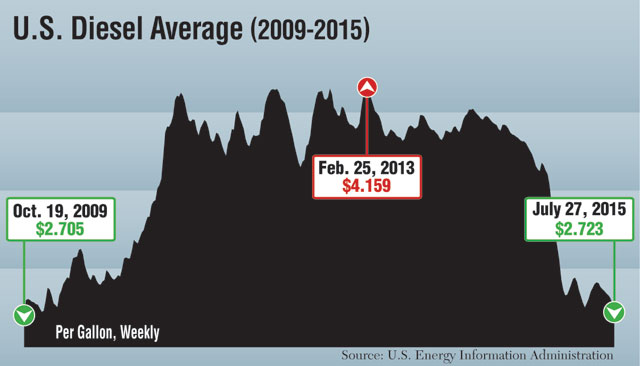Diesel Drops 5.9¢ to $2.723; Lowest Price in Nearly Six Years

Diesel’s national average price tumbled to its lowest point in almost six years last week, falling 5.9 cents to $2.723 per gallon, according to a July 27 report from the Department of Energy. The last time diesel was lower than the current price was the week of Oct. 19, 2009, when it was $2.705.
Diesel was $1.135 cheaper than a year ago after its ninth consecutive decline, the agency reported from its weekly survey of fueling stations. The 5.9-cent drop is the largest one-week slide since Jan. 26, when it fell 6.7 cents to $2.866 from $2.933.
The nine-week stretch is the longest period of consecutive declines this year and the longest streak since the 12 weeks ended Feb. 2. The average price of trucking’s main fuel has fallen 19.1 cents since its most recent peak of $2.914 on May 25.
The lower prices for diesel are “certainly going to help us operationally — we are in the forest products industry, and it hasn’t been as easy for us to pass along fuel surcharges,” said Mark Gibson, president of Siskiyou Transportation Inc. in Ashland, Oregon.
“While the cost of fuel is, in fact, decreasing — and that will be a positive thing — it by no means will be a windfall for us,” Gibson added. “It’s just going to basically help us recapture some of those other price increases we’ve been having to absorb the last few years. The price of new trucks has gone up. The price of parts, repairs, maintenance and just the overall cost of business has gone up.”
In the near-term, at least, the price of diesel is expected to remain at current levels, thanks in part to a glut of supply, analysts said.
“There’s been a surge in refining capacity for diesel from Saudi Arabia and China and a couple others that have put a great deal of additional supply onto the global market,” said John Kilduff, a partner with Again Capital, in New York. “It’s impacting U.S. ability to export some barrels and just driving down the diesel fuel price globally, which looks like it is finally trickling over and impacting the U.S. market.”
In fact, Kilduff expects diesel prices to keep falling until lower temperatures lift demand for heating oil.
“Prices should continue to slide until at least mid- to late October,” he said, “before demand could possibly kick in from the Northern Hemisphere winter and the associated winter fuel demand.”
Sociopolitical factors also could play a role, as the United States’ recent nuclear deal and a strengthening dollar “could continue to press oil lower,” Bank of America said in a July 24 note. The bank cut its third-quarter average price estimate for Brent to $50 a barrel from $54, while West Texas Intermediate was lowered to $45 from $50, Bloomberg News reported.
Gasoline’s average price is also dropping, sliding 5.7 cents last week to a 10-week low of $2.745. A year ago at this time, gasoline cost $3.539 per gallon.
Gasoline remained at a higher national average price than diesel for the third week in a row. Gasoline prices fell in every area of the country except for the Rocky Mountain area, where prices went up in Denver by 3.2 cents, in Colorado by 4.7 cents, and in the entire Rocky Mountain region by 1.5 cent.
The price of diesel has now fallen below $3 a gallon almost everywhere; the lone holdout is California, where it remains at $3.072. On the West Coast, gasoline is was $3.545 a gallon.
Across the country, diesel was cheapest in the Gulf Coast region at $2.611 a gallon. The largest price drop last week was in the Central Atlantic, where the average price of diesel fell 6.7 cents to $2.918 a gallon.
Even as the price of diesel continues to decline, carriers are continuing fuel-saving practices, including upgrading equipment.
“We’ve rented newer trailers that have side skirts, and that has created fuel savings, and we have invested in new tractors with better fuel economy and are phasing out the old ones,” said John Hagen, general manager of OMI Transportation in Toledo, Ohio.
Siskiyou also has invested in new trucks to keep fuel costs down, Gibson said, but he noted it has fewer options to reduce fuel usage.
“The only thing we have been able to do is upgrade our fleet to newer trucks,” he said. “In the type of industry we are in — more vocational — there’s not a lot of things you can do drivewise to decrease fuel consumption. We got logging trucks hauling logs out of the woods, and we got idling time and that type of thing, so we do what we can, but our options are far more limited than an over-the-road truck would be,” he said.




